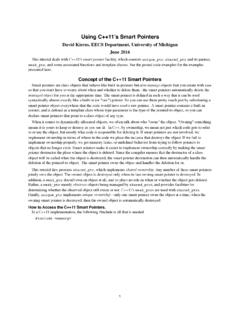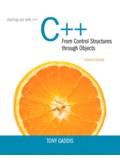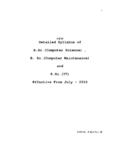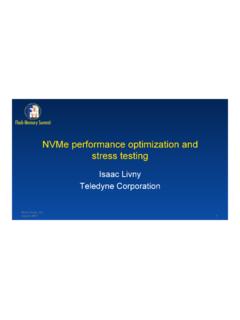Transcription of 244-31: Think FAST! Use Memory Tables (Hashing) for Faster ...
1 1 Paper 244-31 Think FAST! Use Memory Tables ( hashing ) for Faster merging Gregg P. Snell, Data Savant Consulting, Shawnee, KS ABSTRACT The objective of this paper is to present a simple way to merge datasets using Memory Tables . Well, actually, it will be an associative array (or hash) object. However, by simply thinking of this object as an in- Memory table , it just may help you to grasp the hashing concepts and feel less intimidated about learning and using (what I believe is) the fastest method available for merging datasets. INTRODUCTION merging datasets is something we all do. Unfortunately, the bigger the files get and the more often you need to do it, the Faster you want the process to be. Like many of you, I learned how to use sort and match- merging very early in my SAS career and it became a mainstay for joining Tables . The method is simple, strait forward, and it works FAST! Prudent use of indexes can make match- merging even Faster by eliminating the need to sort and thus reducing I/O.
2 Indexes also allow you to make use of key-indexing techniques. But now with SAS 9, hashing is (within certain limitations) the FASTEST way to merge. Unfortunately, many of you still have not taken the time to learn about hashing , in part, because so much of the syntax and terminology seems foreign. This paper is an attempt to remedy that situation by presenting examples of basic hashing concepts in simple terms as they relate to traditional SAS code. hashing DEFINED hashing is the process of converting a long-range key (numeric or character) to a smaller-range integer number with a mathematical algorithm or function coupled with key-indexing. Key-indexing is the concept of using the value of a table s key as the index into that table , using zip code values as the index of the key variable: client(66216)= POTENTIAL CLIENT ; hashing (as a hand-coded process) was introduced to the SAS world by Paul Dorfman at SUGI 25 with Private Detectives In A Data Warehouse: Key-Indexing, Bitmapping, And hashing .
3 With the release of SAS 9, hashing was incorporated into the DATA step with two predefined component objects: the hash object and the hash iterator object. These objects provide a quick and efficient method to store, search, and retrieve data based on lookup keys. For the purposes of this paper I will only be covering the hash object. An explanation of how to use the iterator object can be found in hashing : Generations which I presented at SUGI 28 along with Paul Dorfman. Full details on hashing syntax can be found in the SAS OnlineDoc Look under the contents tab and select: Base SAS > SAS Language Reference: Concepts > DATA Step Concepts > Using DATA Step Component Objects. PROPAEDEUTICS Unfortunately, the new hashing syntax uses component objects and something called attributes and methods as opposed to good old fashioned statements . But do not worry. You only need to learn a handful of new commands to do basic merging and I will show them alongside traditional merge code.
4 However, to effectively use these new hashing commands, you must have a good understanding of sequential/direct access, implicit/explicit looping and indexes. So before I jump into the hashing code, let me offer a quick review these three DATA step concepts. SEQUENTIAL/DIRECT ACCESS Sequential access is the concept of accessing (or reading) records from a table in sequential order, from the top to bottom, one after another. Here is a very simple example: /* sequential access */ data ; set ; put _all_; output; run; TutorialsSUGI31 2 Name=Alfred Sex=M Age=14 Height=69 Weight= _ERROR_=0 _N_=1 Name=Alice Sex=F Age=13 Height= Weight=84 _ERROR_=0 _N_=2 Name=Barbara Sex=F Age=13 Height= Weight=98 _ERROR_=0 _N_=3 Name=Carol Sex=F Age=14 Height= Weight= _ERROR_=0 _N_=4 Name=Henry Sex=M Age=14 Height= Weight= _ERROR_=0 _N_=5 Name=James Sex=M Age=12 Height= Weight=83 _ERROR_=0 _N_=6 Name=Jane Sex=F Age=12 Height= Weight= _ERROR_=0 _N_=7 Name=Janet Sex=F Age=15 Height= Weight= _ERROR_=0 _N_=8 Name=Jeffrey Sex=M Age=13 Height= Weight=84 _ERROR_=0 _N_=9 Name=John Sex=M Age=12 Height=59 Weight= _ERROR_=0 _N_=10 Name=Joyce Sex=F Age=11 Height= Weight= _ERROR_=0 _N_=11 Name=Judy Sex=F Age=14 Height= Weight=90 _ERROR_=0 _N_=12 Name=Louise Sex=F Age=12 Height= Weight=77 _ERROR_=0 _N_=13 Name=Mary Sex=F Age=15 Height= Weight=112 _ERROR_=0 _N_=14
5 Name=Philip Sex=M Age=16 Height=72 Weight=150 _ERROR_=0 _N_=15 Name=Robert Sex=M Age=12 Height= Weight=128 _ERROR_=0 _N_=16 Name=Ronald Sex=M Age=15 Height=67 Weight=133 _ERROR_=0 _N_=17 Name=Thomas Sex=M Age=11 Height= Weight=85 _ERROR_=0 _N_=18 Name=William Sex=M Age=15 Height= Weight=112 _ERROR_=0 _N_=19 NOTE: There were 19 observations read from the data set NOTE: The data set has 19 observations and 5 variables. NOTE: DATA statement used (Total process time): real time seconds cpu time seconds As you can see by the sequence of _N_ values, records were read from the table sequentially from top to bottom. Direct access is the concept of accessing (or reading) specific records from a table in no particular order. To do this, you must specify which row(s) to read. Here is a very simple example that reads records by the observation or _N_ value: /* direct access */ data ; do i=2, 3, 9; set point=i; put _all_; output; end; stop; run; i=2 Name=Alice Sex=F Age=13 Height= Weight=84 _ERROR_=0 _N_=1 i=3 Name=Barbara Sex=F Age=13 Height= Weight=98 _ERROR_=0 _N_=1 i=9 Name=Jeffrey Sex=M Age=13 Height= Weight=84 _ERROR_=0 _N_=1 NOTE: The data set has 3 observations and 5 variables.
6 NOTE: DATA statement used (Total process time): real time seconds cpu time seconds In this example, the row number value was stored in variable i. The point= option with the set statement read specific rows from the table . If this concept is new to you then I would encourage you to read more about it in the SAS OnlineDoc under contents: Base SAS > SAS Language Reference: Dictionary > Dictionary of Language Elements > Statements > SET Statement. Another method of direct access will be described with the explanation of indexes. IMPLICIT/EXPLICIT LOOPING By default, DATA steps execute under an implicit loop beginning with the first record of the table and looping through all the statements within the step until the last record is accessed. By doing this SAS is smart enough to know when the end-of-file (EOF) has been encountered and exits the implicit loop. However, you do not have to accept the default and can explicitly specify the looping.
7 Here are two examples of sequential code presented side-by-side to further illustrate this concept. Both of these code snippets essentially do the exact same thing: TutorialsSUGI31 3 /* implicit looping */ /* explicit looping */ data ; data ; do until (eof); set ; set end=eof; put _all_; put _all_; output; output; end; run; run; Please keep in mind that when directly accessing Tables , SAS has no way of knowing when you are finished reading records. Consequently, you must utilize explicit looping to prevent an endless loop. In the previous direct access example, I used the stop statement to terminate looping with only a single pass through the DATA step. Just for grins, rerun that example without the stop statement just be prepared to interrupt the job or it will run forever!
8 INDEXES An index is an optional file created for a SAS dataset that provides direct access to specific records based on key values. The index stores the key values in ascending order for the designated variables and includes pointers to the records matching the corresponding values. You can learn greater details about creating and using indexes from the SAS OnlineDoc under contents: Base SAS > SAS Language Reference: Concepts > SAS Files Concepts > SAS Data Files > Understanding SAS Indexes. Remember how the previous direct access example pointed to specific table records by row number? If the table had an index, I could have directly accessed specific records based on a value, rather than the row number, which makes much more sense programatically. What would an index look like? Well, we can not open or look at SAS indexes, but here is an example you can run to simulate an index: /* simulate an index on variable: age */ data ; set ; row_id=_n_; keep age row_id; run; proc sort data= ; by age row_id; run; data ; keep age rid; retain age rid; length rid $20; set ; by age; if then rid = trim(put(row_id, )); else rid = trim(rid) || ',' || trim(put(row_id, )); if then output; run; TutorialsSUGI31 4 You will notice that the table is in ascending order of the index variable age.
9 Variable rid (which is character for display purposes only) contains all of the row numbers with corresponding values of age. This is what I Think a SAS index file looks like. Now, let us build a real index and then retrieve the values in ascending order: options msglevel=i; /* class with index*/ data (index=(age)); set ; run; NOTE: There were 19 observations read from the data set NOTE: The data set has 19 observations and 5 variables. NOTE: Simple index age has been defined. NOTE: DATA statement used (Total process time): real time seconds cpu time seconds /* sequential access in ascending order */ data ; set ; by age; run; INFO: Index Age selected for BY clause processing. NOTE: There were 19 observations read from the data set NOTE: The data set has 19 observations and 5 variables. NOTE: DATA statement used (Total process time): real time seconds cpu time seconds TutorialsSUGI31 5 Here you can see that we were able to access the unsorted table in ascending order of age because an index stores values in ascending order.
10 Of course, this does not do you much good if you need a descending sort. Also, not having to sort Tables may save some processing time but be aware that there are CPU and I/O costs associated with creating and using indexes. To learn more about this, look for Deciding Whether to Create an Index in the SAS OnlineDoc contents: Base SAS > SAS Language Reference: Concepts > SAS Files Concepts > SAS Data Files > Understanding SAS Indexes. But the real benefit of indexes is that they provide direct access to specific observations by value rather than simply row number. You may not know how many, or which, records will match your criteria, but the index does! So, if I wanted to read only those records with an age value of 13 or 14, I could use the key= option: /* direct access */ data ; do age=13,14; do until (eof); set class key=age end=eof; if _IORC_=0 then do; /* 0 indicates a match was found */ put _all_; output; end; else _ERROR_=0; /* if no match, reset the error flag and continue */ end; end; stop; run.

















